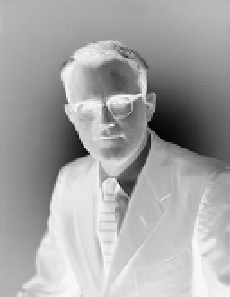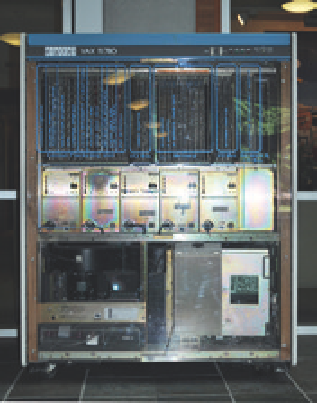Information Technology Reference
In-Depth Information
The architecture of the PDP-11 popularized the idea of a
bus
, a set of
connections linking all the major components of the machine, including
the central processor, memory, and I/O devices, in a standard way. The
bus architecture was important because it allowed both DEC and “orig-
inal equipment manufacturers” - often known as OEMs - to easily add
extra units and to customize the machine for specialized applications. By
the mid-1970s, the minicomputer market had become very competitive
and DEC needed to offer a computer with more memory than the PDP-
11, a 16-bit computer that could access 64 kilobytes of memory. The VAX
11/780, announced in October 1977, was the first commercially available
32-bit computer. It supported 2
32
or 4 gigabytes of virtual address space.
Virtual memory
is a mechanism for swapping data in and out of a small, fast
main memory from a slower, larger memory on a
hard disk
, a rigid mag-
netic disk permanently mounted in the computer's disk drive and used
to store data. The VAX had sixteen 32-bit registers and could understand
a large, complex
instruction set
(set of commands). The computer archi-
tect Gordon Bell (
B.8.14
) led the initial design effort for the VAX, as head
of DEC's R&D organization. Bell had served as the architect of many of
DEC's successful machines. The VAX turned out to be a runaway success.
It offered cost-effective high performance compared to the much more
expensive mainframe computers. It also had a user-friendly operating sys-
tem called VMS and came with a standard set of languages and library
software (
Fig. 8.23
).
Despite these early successes that allowed DEC to become the sec-
ond-largest computer company through the 1980s, DEC no longer exists.
Although it built the foundation for inexpensive interactive computing, it
missed out on the personal computer revolution. The IBM PC was announced in 1981 and used Intel's 8088
microprocessor, which had all the essential features of a computer on a single chip. So why was DEC not
able to succeed in this new market? Although DEC's founder, Ken Olsen, is often quoted as saying, “There
is no reason for any individual to have a computer in his home,”
37
DEC really tried hard to succeed with
personal computers. In 1982, DEC introduced three incompatible personal computers - the DECmate, based
Fig. 8.23. DEC's very successful VAX-
11/780 computer was the result of a
small architecture team of six engineers
led by Gordon Bell, including Dave
Cutler, who was responsible for the VMS
software architecture and its imple-
mentation. The VMS operating system
was much liked by users but universi-
ties often put up a version of the UNIX
operating system as an alternative. Both
Bell and Cutler later went on to work for
Microsoft.
B.8.14. Gordon Bell grew up in Missouri and helped in the family electrical business, repairing
appliances and wiring homes. He graduated from MIT with a degree in electrical engineering and then
spent time in Australia programming an English Electric DEUCE computer, a production version of Alan
Turing's Pilot ACE computer. In 1960, Bell was recruited by DEC where he worked on the early PDP
machines and designed the first UART - Universal Asynchronous Receiver/Transmitter - that converted
bytes of data and transmitted the individual bits sequentially. As a faculty member at Carnegie Mellon
University, with Allen Newell, he introduced the processor-memory-switch (PMS) and instruction-set
processor (ISP) notations for describing computer structure and architecture. When back at DEC in the
1970s as the head of their R&D organization, he led the design team that developed the enormously
successful VAX computer. In the 1980s, Bell was the founding Assistant Director of the U.S. National
Science Foundation's Computer and Information Science and Engineering Directorate. In 1997 he
established the Gordon Bell Prize for outstanding achievement in high performance computing
applications. In 1995 he joined Microsoft where he built a version of the memex of Vannevar Bush. His
recent work on the MyLifeBits project aims to capture digitally all the significant events each day in a
person's life including geographical locations, conversations, phone calls, messages sent, and even the
web pages visited.




Search WWH ::

Custom Search